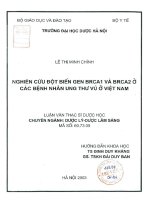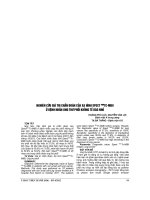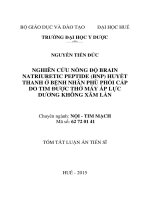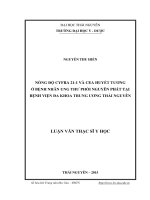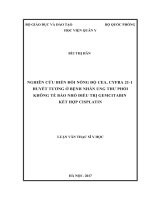Nghiên cứu biểu hiện microRNA 21, microRNA 122 huyết tương ở bệnh nhân ung thư biểu mô tế bào gan nhiễm vi rút viêm gan b tt tiếng anh
Bạn đang xem bản rút gọn của tài liệu. Xem và tải ngay bản đầy đủ của tài liệu tại đây (182.31 KB, 28 trang )
MINISTRY OF EDUCATION AND TRAINING
MINISTRY OF DEFENSE
VIETNAM MILITARY MEDICAL UNIVERSITY
DANG CHIEU DUONG
RESEARCH ON EXPRESSION OF MICRORNA-21,
MICRORNA-122 PLASMA IN HEPATITIS B
VIRUS-RELATED HEPATOCELLULAR
CARCINOMA PATIENTS
Major: Internal Medicine
Code: 9720107
SUMMARY OF MEDICAL DISSERTATION
HANOI- 2020
THIS STUDY HAS BEEN COMPLETED AT
VIETNAM MILITARY MEDICAL UNIVERSITY
Research adviser:
1. Prof. Ph.D. Nguyen Linh Toan
2. Ph.D. Ngo Tat Trung
Reviewer 1: Prof. Ph.D. Vu Van Khien
Reviewer 2: Prof. Ph.D. Phan Van Chi
Reviewer 3: Prof. Ph.D. Bui Vu Huy
The dissertation will be defended in front of Oral Examination
Committee at Vietnam Military Medical University at: ... hour, ...
date ... month ... 2020.
The dissertation can be found at:
- National Library
- Library at Vietname Military Medical University
3
INTRODUCTION
Hepatocellular carcinoma (HCC) represents more than 90%
of primary liver cancers, with the 6th highest incidence and the 4th
highest death rate among the common cancer types in the world. In
Vietnam, HCC ranks first in terms of morbidity and mortality, over
80% is associated with infection with the hepatitis B virus. A good
screening strategy will help to make early diagnosis of HCC, which
is often the combination of abdominal ultrasound and AFP. Besides
classic AFP, a number of other biomarkers have been studied and
applied such as AFP-L3, DCP ... but the desired effects have not been
achieved yet.
MicroRNAs (miRNAs) are small endogenous RNA that do
not encode proteins and play a key role in regulating gene expression
in the post-transcription phase. Many studies in the world have
demonstrated that miR-21, miR-122 plasma are derived from liver
tumor cells and are valuable in the diagnosis, prognosis, and
evaluation of treatment response to HCC. In Vietnam, there have not
been many studies evaluating the expression of plasma miRNA in
HCC patients infected with hepatitis B virus. Therefore, we
conducted the study: “Research on expression of microRNA-21,
microRNA-122 plasma in hepatitis B virus-related hepatocellular
carcinoma patients "with the two following objectives.
1. Evaluate plasma microRNA-21 and microRNA-122
expression levels in
hepatitis B virus-related hepatocellular
carcinoma patients.
2. Analyze
the
relationship
between
microRNA-21,
microRNA-122 plasma with some clinical, subclinical and stage
4
indicators in hepatitis B virus-related hepatocellular carcinoma
patients.
CONTENT OF THE DISSERTATION
This dissertation consists of 137 pages, of which: statements
of the problem – 2 pages, literature review – 35 pages, study
respondents and methods – 20 pages, research results - 45 pages,
discussion - 33 pages, conclusion - 1 page, recommendation - 1 page.
In the disseratation, there are 36 tables, 35 charts, 10 images, 120
references (15 Vietnamese documents, 105 English documents).
NOVELTY OF THE DISSERTATION
This is the first study in Vietnam to study the expression of
miR-21, miR-122 plasma in hepatitis B virus-related hepatocellular
carcinoma patients. The results of the study showed that miR-21 and
miR-122 expression increases in plasma of HCC group compared to
CHB and HC groups, even in cases of early stage of HCC and HCC
with AFP ≤ 20ng / ml.
MiR-21 and miR-122 have higher sensitivity and specificity
than AFP in the diagnosis of HCC with CHB. In the case of early
stage HCC, HCC with AFP ≤ 20ng / ml, miR-21, miR-122 still have
high accuracy when differentiating HCC from CHB (AUC = 0.848;
0.979); (AUC = 0.806; 0.915), HCC from HC (AUC = 0.894; 0.993);
(AUC = 0.935; 0.991) respectively.
The effectiveness of HCC diagnosis with CHB group
increases when combining miR-21, miR-122 with AFP (AUC =
0,868; 0,914).
5
No relationship between miR-21, miR-122 plasma has been
found with ages, genders, some clinical, subclinical symptoms and
the stage of disease in HCC patients with HBV infection. There is
poor correlation between miR-21 and miR-122 plasma with HBV
DNA.
CHAPTER 1. OVERVIEW
1.1. MicroRNA
MicroRNAs (miRNAs) are small endogenous RNA that does
not encode proteins and play an important role in regulating gene
expression. MiRNA prevents code translation by promoting
degradation of the target mRNA. The miRNAs were found to be
involved in histone modification and gene methylation promoters.
The first MiRNA was discovered in 1993 by Victor Ambors
and his colleagues when studying the development of the C. elegans
nematode. By 2014, 2588 human miRNAs were identified. MiRNA
plays an important role in the physiological and cellular pathologies,
such as regulating proliferation, differentiation or apoptosis. In recent
years, a link between miRNAs and chronic liver disease has been
recognized, especially miR-21 and miR-122 in HCC.
Due to its specific tumor properties, circulation and
sustainability in body fluids, miR-21, miR-122 are also found to be
stable in plasma stored at room temperature or negative temperature.
Therefore, this is the scientific basis for the quantitative
application of miR-21, miR-122 in plasma with the tendency as
useful biomarkers for the diagnosis and prognosis of cancer cells.
6
1.2. MicroRNA-21
MicroRNA-21 (miR-21) is a short RNA segment consisting
of 22 nucleotides, the human miR-21 gene is located on chromosome
17 at position 17q23.1, in a transmembrane protein coding gene 49
(TMEM49) also known as 49 vacuolar membrane protein 49. Mature
miR-21 molecule is made up of 22 nucleotides, which is one of the
first miRNA described to be associated with cancer. High
concentrations of miR-21 are found in the plasma of patients with
melanoma, which makes it a potential biomarker for cancer. MiR-21
has been linked to several cancers such as esophageal cancer,
stomach cancer, and colorectal cancer but the most common is HCC.
Recent studies have shown that miR-21 has a higher plasma
expression in patients with HCC and has a higher sensitivity and
specificity than AFP in diagnosing HCC with chronic liver cancer
without cancer. Furthermore, miR-21 has been shown to be
associated with vascular proliferation, invasion and monitoring of
response to treatment.
7
1.3. MicroRNA-122
MicroRNA-122 (miR-122) was originally identified in
mouse liver tissue, accounting for 72% of miRNA analyzed in the
liver. In humans, miR-122 is encoded by a single gene in
chromosome 18 at position 18q21.31. MiR-122 is regulated by Rev Erba alpha, involved in gene expression by adjusting the expression
of many target mRNA molecules. MiR-122 was found to be highly
specific for liver tissue. In the case of HCC related to HBV, miR-122
inhibits viral replication by targeting NDRG3 (N-myc downstreamregulated gene 3), a member of the N-myc gene family.
Research has shown that both miR-122 and NDRG3 in
treatment are feasible for HCC related to HBV. MiR-122 may
represent the primary biomarker in diagnosis and has the potential
for a combination of HBV-related treatment of HBV. The expression
of miR-122 was found to be sharply reduced in the liver tumor tissue
itself, while it was found to increase in the plasma of HCC patients.
This is probably because miR-122 is transferred from tumor tissue
into the bloodstream. Many studies in the world have shown that
miR-122 has high specific sensitivity in HCC diagnosis. Moreover,
miR-122 has been found to be valuable in monitoring response to
some HCC treatments.
CHAPTER 2. SUBJECTS AND METHODS
2.1. SUBJECTS
8
Group of diseases: Including 101 patients with HCC infected
with HBV inpatient treatment at 108 Military Central Hospital .
Control group: Including 46 patients with chronic hepatitis B
(CHB) inpatient treatment at 108 Military Central Hospital and 103
healthy control (HC).
Research period: from March 2014 to March 2017.
2.1.1. Inclusion criteria
2.1.1.1. Group disease
- Patients with HCC were diagnosed following the criteria
issued by the Ministry of Health of Vietnam in 2012:
+ There is evidence of anatomy.
+ Typical image on CT scan taken with contrast injection or
CHT with contrast agent + AFP> 400 ng / ml.
+ Typical image of HCC on CT scan of abdominal abdomen
with contrast or CHT with contrast inhibitors + AFP higher than
normal (less than 400ng / ml) + hepatitis B, C virus infection
- Patients with HCC have positive HBsAg test.
2.1.1.2. Control group
* Patients with chronic hepatitis B: We selected patients with
chronic hepatitis B diagnosed under the guidance of the Ministry of
Health of Vietnam in 2014.
- HBsAg (+) > 6 months or HBsAg (+) and Anti HBc IgG (+).
- AST, ALT increase in installments or over 6 months.
- There is evidence of progressive histopathological damage
identified by a liver biopsy.
9
* Healthy control: are voluntary blood donors without any medical
history, who test negative for HBV, HCV, HIV (including rapid test
and NAT technique: nucleic acid test).
2.1.2. Exclusion criteria
- Patients with HCC have positive anti-HCV test.
- Patients with treated HCC: surgery, Transcatheter arterial
chemoembolization, Radiofrequency ablation, Percutaneous Ethanol
Injection or treatment with sorafenib.
- Patients with co-morbid conditions: Severe heart failure, respiratory
failure, gastrointestinal bleeding and other cancers.
- Patients with severe coagulation disorders: PLT <50 G / L; PT
<50%.
- People who do not agree to participate in the research.
2.2. METHODS
2.2.1. Research design
Cross-sectional descriptive study, with comparative control.
2.2.2. Study sample size
The sample size is identified by convenient sampling
method.
2.2.3. Research facilities
- 9700 PCR machine and Realtime PCR 7500 machine of
Applied Biosystems in USA, installed at Department of Molecular
Biology Department, 108 Military Central Hospital .
2.2.4. Quantitative miR-21, miR-122
10
The miR-21, miR-122 were quantified relatively to the
internal standard by Realtime PCR.
Take 5ml of intravenous blood in the morning when the
patient has not got breakfast into the tube with Ethylenediaminetetra
acid anticoagulant (EDTA), bring immediately to the Department of
Molecular Biology, 108 Military Central Hospital . Centrifuge 3000
rpm for 5 minutes, separate the plasma and stored in minus 800c
refrigerator. When collecting enough samples, quantify miR-21 and
miR-122.
2.2.5. Research indicators
- Age, gender, clinical and subclinical symptoms, characteristics of
liver tumors, stage of liver cancer according to BCLC.
- Expression of miR-21, miR-122 plasma in the study subjects.
2.2.6. Statistical analysis
- Data were processed by medical statistical methods, using SPSS
21.0 software.
- Calculate percentage, average value, standard deviation, median.
Make comparisons to find differences between observations,
determine the diagnostic value of biomarkers using the ROC curve,
calculate the area under the curve (AUC), the sensitivity, the
specificity.
Analyze
relationships
using
logistic
regression,
calculating "OR". Analyze correlation, calculate the correlation
coefficient "r"
2.2.7. Research ethics
The study obeys the ethics of medical research.
11
CHAPTER 3. RESULTS
The study was conducted at 108 Military Central Hospital
from March 2014 to March 2017. Included 101 patients with HCC,
46 patients with CHB, 103 healthy people eligible for selection.
3.1. Research group characteristics
3.1.1. Clinical and laboratory characteristics of research subjects
- Average age of patients with HCC (55,6 ± 12,34), patients
at least 23 years old, the largest patients are 92 years old. Male
account for the majority (93.1%), female (6.9%), male / female ratio
~ 13/1.
- Common functional symptoms of liver cancer are fatigue
(63.4%), anorexia (61.4%), pain in the lower right flank (61.4%),
weight loss (47.5%).
- Systemic symptoms are frequently seen as vascular disease
(14.85%), lipstick hands (11.88%), jaundice (10.89%), less common
symptoms such as fever, edema, subcutaneous hemorrhage have the
same rate (1.98%).
- The most common physical symptom in hepatocellular
carcinoma is hepatomegaly (21.78%), less common symptoms such
as splenomegaly (6.93%), portal vena cava (3.96%), No patients had
ascites.
- Hepatic enzyme activity of AST, ALT, total bilirubin and
HBV load in HCC group are lower than in CHB group (p <0.05).
AFP concentration was higher in the HCC group than in the CH
group (p <0.05).
- Patients with HCC had AFP ≤ 20ng / ml, accounting for
35.6%.
12
3.1.2. Liver tumor characteristics
- Patients with HCC have one tumor (64.36%), 2-3 tumors
(13.86%), over 3 tumors (21.78%).
- The largest average size of the tumors (7.78 ± 3.41) cm.
Patients with liver tumors of less than 5cm size (28.71%).
- Patients with HCC have portal vein thrombosis (22.77%).
- Patients with HCC have moderate cell differentiation in the
majority (45.55%), high differentiation (24.75%), low differentiation
(9.90%).
- Classification of stage Barcelona Clinic Liver Cancer
(BCLC): A (15.84%), B (49.51%), C (34.65%).
3.2. Expression of miR-21, miR-122 in the study subjects
3.2.1. Expression of miR-21, miR-122 in patients with HCC, CH
and HC
Table 3.13. Expression of miR-21 plasma in patients with HCC,
miR-21 (2-ΔCt)
CHB and HC
X ± SD
Median
Value range
HCC (n=101)
10,78
194,05 ± 564,16
0,10 – 3743,05
CHB (n=46)
2,02
3,79 ± 7,46
0,12 – 50,91
HC
0,73
0,83 ± 0,55
0,10 – 2,42
(n=103)
13
Comments: The value of miR-21 plasma fluctuated in a large
range among the study groups. MiR-21 in the HCC group had greater
manifestations than the CHB and HC groups.
Table 3.14. Expression of miR-122 plasma in patients with HCC,
miR-122 (2
-ΔCt
)
CHB and HC
X ± SD
Median
Value range
HCC (n=101)
436,54
3158,58 ± 7707,36 0,14 – 47975,16
CHB (n=46)
3,61
31,63 ± 84,27
0,002 – 508,46
HC (n=103)
0,10
1,07 ± 2,09
0,00002 – 13,17
Comments: The miR-122 plasma values fluctuated in a wide
range among the study groups. MiR-122 of the HCC group had
greater expressions than the CHB and HC groups.
Figure 3.5. ROC curves of miR-21, miR-122 in patients with HCC
and CHB
Comments: In the diagnosis between patients with HCC and
CHB, miR-21 has sensitivity (68.3%), specificity (78.3%); miR-122
has a sensitivity (79.2%) and specificity (89.1%). The specificity of
14
miR-122 is higher than the specificity of miR-21 in the diagnosis
between the HCC and CHB groups.
Figure 3.7. ROC curves of AFP, miR-21, miR-122 in patients with
HCC and CHB
Comment: The charge under the curve of miR-21 is greater
than the charge under the curve of AFP but not statistically
significant (p> 0.05). The area under the curve of miR-122 is larger
than the area under the curve of AFP and miR-21 is significant with
(p <0.05).
- When combining miR-21 with AFP, the charge under the
curve increased significantly compared with miR-21 and AFP alone
(p <0.05).
- When combining miR-122 and AFP, the charge under the
curve was higher than that of AFP (p <0.05), but not significantly
increased compared to miR-122 (p> 0.05).
- The area under the curve of miR-21 in combination with
AFP is smaller than the area under the curve of miR-122 in
combination with AFP (p <0.05). In combination with miR-21, miR-
15
122 with AFP showed an increase in charge under the curve
compared with miR-21 in combination with AFP (p <0.05).
Figure 3.12. ROC curves of miR-21, miR-122 in patients with HCC
and HC
Comment: In the diagnosis between patients with HCC and
HC, miR-21 had sensitivity (81.2%), specificity (94.2%); miR-122
has a sensitivity (94.1%) and specificity (99.0%).
3.2.2. Expression of miR-21, miR-122 in patients with HCC with
AFP ≤ 20ng / ml
- Expression of miR-21, miR-122 plasma in patients with
HCC with AFP ≤ 20ng / ml is higher than in patients with CHB and
HC (p <0.001).
Table 3.23. Sensitivity, specificity of miR-21, miR-122 in the
diagnosis of HCC with AFP ≤ 20ng / ml and CHB
HCC (n = 36)
CH
(n = 46)
miR-21 (2
-∆Ct
)
AUC
0,80
Cut
Sensitivity
Specificity
point
(%)
(%)
3,62
75,0
78,3
16
6
-∆Ct
miR-122 (2
)
0,91
55,33
80,6
89,1
5
Comments: In the diagnosis between patients with HCC with
AFP ≤ 20ng / ml and CH: miR-21 has sensitivity (75%), specificity
(78.3%); miR-122 has sensitivity (80.6%), specificity (89.1%).
Table 3.25. Sensitivity, specificity of miR-21, miR-122 in the
diagnosis of HCC with AFP ≤ 20ng / ml and HC
HCC
(n = 36)
HC
(n =
AUC
103)
miR-21 (2-∆Ct)
0,93
Cut
Sensitivity
Specificity
point
(%)
(%)
2,17
83,3
98,1
8,3
94,4
99,0
5
-∆Ct
miR-122 (2
)
0,99
1
Comments: In the diagnosis between patients with HCC with
AFP ≤ 20ng / ml and HC: miR-21 has sensitivity (83.3%) specificity
(98.1%); miR-122 has a sensitivity (94.4%) and specificity (99%).
3.2.3. Expression of miR-21, miR-122 in patients with early stage
HCC
- Expression of miR-21, miR-122 increased in plasma of
early stage HCC plasma (BCLC: A) compared with CH and HC
group (p <0.001).
Table 3.27. Area under the curve of AFP, miR-21, miR-122 in early
stage HCC and CH diagnosis
Indicator
Area under the curve
(AUC)
P
17
AFP (1)
0,617
p1,2 < 0,05
miR-21 (2)
0,848
p1,3 < 0,05
miR-122 (3)
0,979
p2,3 < 0,05
Comments: miR-21, miR-122 are highly valuable for early
diagnosis of early stage HCC and CHB. The area under the curve of
miR-21, miR-122 is larger than the area under the curve of AFP in
early stage HCC and CHB diagnosis (p <0.05).
Table 3.28. Area under the curve of miR-21, miR-122 in early stage
diagnosis of HCC and HC
Area under the curve
Indicator
p
(AUC)
miR-21
0,894
miR-122
0,993
p < 0,05
Comments: miR-21, miR-122 have high value in early stage
diagnosis of HCC and HC. The area under the curve of miR-122 is
larger than the area under the curve of miR-21 in early stage
diagnosis and HC (p <0.05).
3.3. The relationship between miR-21 and miR-122 with some
clinical, subclinical and disease indicators in patients with HCC.
Table 3.29. Correlation between miR-21 and miR-122 with age
Age
HCC
miR-21
miR-122
R
P
r
p
0,157
> 0,05
0,163
> 0,05
Comment: No correlation between miR-21 and miR-122
plasma has been found with age in patients with HCC (| r | <0.3; p>
0.05).
18
Table 3.30. Relationship between miR-21, miR-122 and gender
Gende
r
miR-21
miR-122
(95%
(95%
OR
p
CI)
CI)
0,071 0,295 HCC
0,383 0,266
1,391 0,676
2,075
6,559
Comment: No relationship between miR-21, miR-122
OR
P
plasma and gender was found in the patients with HCC (p> 0.05).
19
Table 3.33. Correlation between miR-21 and some laboratory
indicators in patients with HCC
miR-21
Indicator
Platelet (G/L)
Prothrombin (%)
AST (U/L)
ALT (U/L)
Blirubin TP (µmol/l)
Protein TP (g/l)
Albumin (g/l)
AFP (ng/ml)
HBV-DNA{Log(copy/ml)}
Correlation
coefficients (r)
- 0,139
0,102
- 0,037
0,012
- 0,107
- 0,128
0,047
- 0,008
0,502
p
> 0,05
> 0,05
> 0,05
> 0,05
> 0,05
> 0,05
> 0,05
> 0,05
< 0,05
Comment: No correlation between miR-21 and platelet
counts, prothrombin ratio, AST, ALT, total bilirubin, total protein,
Abumin and AFP levels in patients with HCC (| r | <0.03; p> 0.05).
There was a weak correlation between miR-21 plasma and HBV
DNA (r = 0.502; p <0.05).
20
Table 3.34. Correlation between miR-122 and some laboratory
indicators in patients with HCC
miR-122
Indicator
Platelet (G/L)
Prothrombin (%)
AST (U/L)
ALT (U/L)
Blirubin TP (µmol/l)
Protein TP (g/l)
Albumin (g/l)
AFP (ng/ml)
HBV-DNA {Log(copy/ml)}
Correlation
coefficients (r)
- 0,051
0,186
- 0,097
- 0,037
- 0,131
- 0,076
0,159
0,004
0,369
p
> 0,05
> 0,05
> 0,05
> 0,05
> 0,05
> 0,05
> 0,05
> 0,05
< 0,05
Comment: No correlation between miR-122 and platelet
counts, prothrombin ratio, AST, ALT, total bilirubin, total protein,
Abumin and AFP levels in patients with HCC (| r | <0.03; p> 0.05).
There was a weak correlation between miR-122 plasma and HBV
DNA (r = 0,369; p <0.05).
Table 3.35. Relationship between miR-21 and liver function
according to Child - Pugh classification, liver tumor characteristics
and disease stage according to BCLC
Indicator
Child – Pugh
Tumor number
Tumor size
Vascular invasion
Tumor differentiation
OR
1,316
0,868
0,883
1,148
1,710
miR-21
p
0,665
0,733
0,777
0,771
0,141
(95% CI)
0,379 - 4,565
0,384 - 1,961
0,373 - 2,092
0,453 - 2,913
0,837 - 3,492
21
BCLC
1,092
0,756
0,627 - 1,902
Comment: There is no relation between miR-21 plasma and
liver function according to Child - Pugh classification, tumor
number, tumor size, vascular invasion, tumor differentiation, and
stage of cancer by BCLC classification (p> 0.05).
Table 3.36. Relationship between miR-122 and liver function
according to Child - Pugh classification, tumor tumor characteristics
and disease stage according to BCLC
miR-122
Indicator
OR
p
Child – Pugh
1,316
0,665
Tumor number
1,031
0,941
Tumor size
0,489
0,112
Vascular invasion
0,731
0,511
Tumor differentiation
1,219
0,575
BCLC
0,730
0,272
(95% CI)
0,379 - 4,565
0,457 - 2,328
0,202 - 1,182
0,286 - 1,864
0,609 - 2,441
0,416 - 1,280
Comment: There is no relation between miR-122 plasma and
liver function according to Child - Pugh classification, tumor
number, tumor size, vascular invasion, tumor differentiation, and
stage of cancer by BCLC classification (p> 0.05).
Chapter 4. DISCUSSIONS
4.1. Research group characteristics
HCC can appear in patients at any age, but there are
differences in incidence in different age groups. In our study, the age
range of HCC patients prevention is quite wide, the youngest is 23
years old, the oldest is 92 years old, the average age (55.6 ± 12.34),
22
the male account for the majority (93, 1%), female (6.9%), male /
female ratio ~ 13/1.
HCC usually progresses silently. Once the symptoms are
visible, they are at an advanced stage, the tumor is large in size or
with impaired hepatic function. The results of our study showed that
common mechanical symptoms are fatigue (63.4%), anorexia
(61.4%), right upper quadrant pain (61.4%), weight loss ( 47.5%).
The most physical symptom is hepatomegaly (21.78%). The average
AFP concentration in HCC patients (339.29 ± 574.02) ng / ml, of
which 35.6% of HCC patients had serum AFP at ≤ 20ng / ml.
In our study, the majority of cases have large size liver
tumors, the largest average size of the tumor (7.78 ± 3.41) cm.
Patients with liver tumors of less than 5cm size only account for
(28.71%). Patients had one tumor (64.36%), multiple liver tumors
were found in 35.64% of which 2-3 tumors (13.86%), over 3 tumors
(21.78%). Our results are similar to the findings of some domestic
and foreign authors, the majority of HCC patients have a liver tumor.
Vascular invasion is a sign of late stage of cancer, showing the spread
and destruction of the cancer organization into nearby blood vessels
such as portal vein, liver vein and lower vena cava ...The pattern of
vascular invasion is shown by the image of venous thrombosis, the
proportion of portal venous thrombosis in our study accounts for
22.77%. Cellular differentiation is an indispensable factor when it
comes to any type of cancer. In HCC, differentiation is considered to
be an important prognostic factor. In our study, patients with HCC
had moderate cell differentiation (45.55%), high differentiation
(24.75%), and low-grade (9.90%). Unspecified (19.80%), these are
23
cases of bright cell type HCC and fine needle aspiration FNA is
applied. Our rate of differentiation of cancer cell group is similar to
that of Thai Doan Ky, Nguyen Tien Thinh and Le Van Truong. In this
study, we used the BCLC classification system to assess the stage of
disease of patients with cancer. The research results showed that
patients with HCC mediated stage B accounted for 49.51%, the
progression of BCLC C (34.65%), the early stage BCLC A (15.84%),
there was no late stage BCLC D HCC patient.
4.2. Expression of miR-21, miR-122 in HCC patients
In our research findings, miR-21, miR-122 showed higher
plasma expression in HCC group than in chronic hepatitis B patients
and healthy people with p <0.001. High expression of miR-21 in
hepatocellular carcinoma has been reported for many years. In a
study at Ohio University in the US in 2007, author Meng F. et al.
reported an increased expression of miR-21 in liver cancer tissue
compared with healthy liver tissue in humans. Research by
Tomimaru Y. et al. (2012) in Japan showed that miR-21 expression
was higher in plasma of HCC patients compared with CHB patients
and healthy control with p <0.0001. In a study in China in May 2017,
author Guo X. and his colleagues studied serum miR-21 expression
in 453 respondents including 175 patients with HCC, 64 patients
with chronic hepatitis B, 78 cirrhosis patients and 136 healthy
volunteers. Results showed that serum miR-21 was significantly
higher in HCC group than in chronic hepatitis B group, cirrhosis and
healthy people (p <0.0001). Kutay H. (2006) from Ohio State
University Medical School studied the changes of miRNA in mouse
liver tissue experimentally induced by HCC. Results showed that
24
miR-122 was strongly expressed in healthy liver tissue, while miR122 was severely reduced in cancerous liver tissue. While the
expression of cancerous liver tissue was reduced, miR-122 was
found to be increased in plasma in patients with HCC compared with
those without HCC. The study involved 152 respondents, including
70 HCC patients infected with HBV, 48 patients with chronic
hepatitis B without cancer and 34 healthy volunteers by author Qi P.
et al. (2011). Results showed that expression of miR-122 plasma was
statistically significantly increased in patients with HCC compared
with healthy subjects (p <0.001) and chronic hepatitis B (p <0.05).
Similar to our study, the study on HCC patients in India in 2019,
Bharali, D and colleagues found that miR-21 and miR-122
expression increased significantly in the HCC patient group
compared with cirrhotic group, chronic hepatitis and healthy people
with p <0.05.
Investigate the values of miR-21, miR-122 in distinguishing
HCC diagnosis from CHB and HC. Our research results show that
miR-21, miR-122 have high specific sensitivity. In particular, the
area under the curve, the specific sensitivity of miR-122 is higher
than the charge under the curve, the specific sensitivity of miR-21 in
diagnosis between HCC patients and CHB patients and HC.
Moreover, when comparing the diagnostic value of miR-21, miR-122
with AFP through the area under the curve it shows that the area
under the curve of miR-21, miR-122 is larger than the area under the
curve of AFP. Our results are similar to those of some authors in the
world that miR-21, miR-122 have higher specific sensitivity than
AFP in HCC diagnosis for control groups. When combining miR-21
25
with AFP, the charge under the curve increased significantly
compared with miR-21 and AFP alone p <0.05. Or when combining
miR-122 with AFP, the charge under the curve is higher than that of
single AFP p <0.05. This result shows that the combination of miR21, miR-122 with AFP increases the diagnostic efficacy of AFP and
therefore can complement AFP in HCC diagnosis.
Moreover, our research results showed that the expression of
miR-21, miR-122 increased in plasma in the group of HCC patients
with AFP ≤ 20ng / ml compared to the group of CHB patients and
healthy (p < 0.001). In the diagnosis among HCC group, there was
AFP ≤ 20ng / ml with CHB, the area under the curve, the sensitivity,
specificity of miR-21, miR-122 were at (0.806; 75.0%; 78.3%). and
(0.915; 80.6%; 89.1%) respectively. Similarly, between HCC group,
AFP ≤ 20ng / ml and healthy group, area under curve, sensitivity,
specificity of miR-21, miR-122 (0.935; 83.3%; 98.1% ) and (0.991;
94.4%; 99.0%) respectively. In both cases, miR-122 had a higher
specific sensitivity than miR-21 (p <0.05). We investigated the
diagnostic value of miR-21, miR-122 in early HCC patients group
(BCLC A) with control groups including CHB and HC. The results
showed that miR-21, miR-122 were highly effective in diagnosing
HCC with CHB (AUC = 0.848; 0.979), HCC with HC (AUC =
0.894; 0.993). Especially miR-21, miR-122 had higher value than
AFP in diagnosis between early stage HCC group and CH group (p
<0.05).
4.3. Relationship between miR-21 and miR-122 with some
clinical, subclinical and disease indicators in HCC patients.


